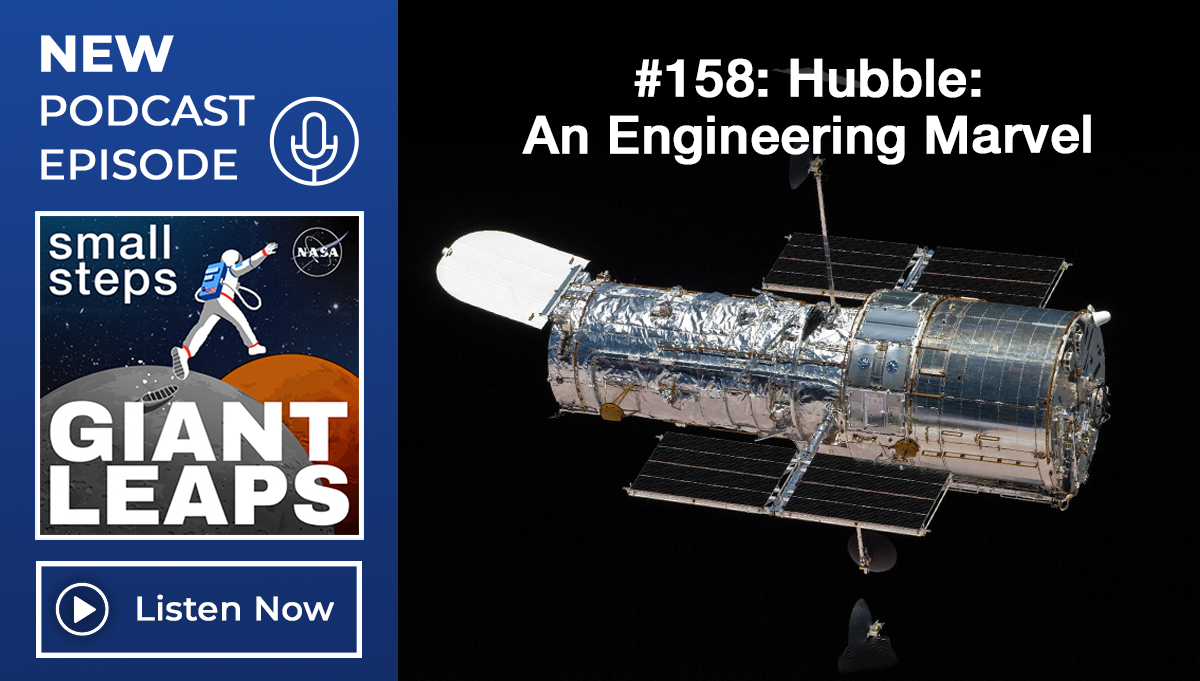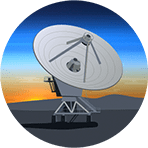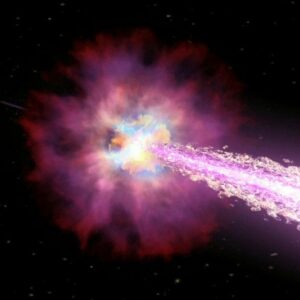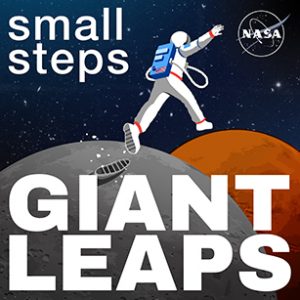StarBurst, a satellite the size of a washing machine, aims to detect the initial blast of gamma-rays, the most powerful bursts of energy in the universe. These huge explosions can occur when dense neutron stars collide, forging metals like gold and platinum. These metals are some of the building blocks of planets — like Earth.
The merging of dense neutron stars forges heavy elements such as gold and platinum, revealing the origins of some of Earth’s building blocks. StarBurst, a satellite the size of a washing machine, aims to detect the initial gamma-ray bursts from these explosive cosmic events.
In this episode, you’ll learn about:
- Why we study gamma-ray bursts
- How the idea for StarBurst was conceived
- The value of acceptable risk in project management
 Dr. Dan Kocevski is the principal investigator for StarBurst, a low-cost NASA Astrophysics Pioneers Program mission that will study short gamma-ray bursts. He also works as a research astrophysicist on the Fermi Gamma-ray Space Telescope mission.
Dr. Dan Kocevski is the principal investigator for StarBurst, a low-cost NASA Astrophysics Pioneers Program mission that will study short gamma-ray bursts. He also works as a research astrophysicist on the Fermi Gamma-ray Space Telescope mission.
Dr. Kocevski specializes in time‑domain, multi‑messenger astronomy with a focus on gamma‑ray bursts (GRBs), their host galaxies, and electromagnetic counterparts to gravitational wave and neutrino events. He led the development of major public data portals for the Fermi mission—including the Femi All-sky Variability flare archive, the Fermi‑LAT GRB table, and interactive Fermi‑LAT source catalog tools—vastly improving community and public access to Fermi science data. Dr. Kocevski received a Bachelor of Science from the University of Michigan and a Ph.D. from Rice University. He was a Postdoctoral Fellow at the University of California, Berkeley from 2005-2008 and then at Stanford University from 2008-2012.
Resources
StarBurst mission page
NASA Astrophysics Division
Gamma-ray bursts
APPEL Courses
Introduction to Software Engineering
Lessons Learned and Knowledge Sharing at NASA
Complex Decision Making in Project Management
Transcript
Andres Almeida (Host): What happens when extremely dense neutron stars – which are only several miles across – collide? They unleash what’s called gamma-ray bursts, the brightest, most energetic explosions known to science. In the process, the collision forges heavy metals like gold and platinum, elements which are plentiful on Earth.
NASA’s StarBurst mission, a satellite about the size of a washing machine, is set to launch in 2027 to detect the initial blasts of these cosmic fireworks. By studying gamma-ray bursts in unprecedented detail, StarBurst will help scientists probe the extreme physics of neutron star collisions and shed light on one of the most powerful events in astrophysics. We’re talking about it today with Dr. Dan Kocevski, principal investigator for StarBurst, out of NASA’s Marshall Space Flight Center in Huntsville, Alabama. This is Small Steps, Giant Leaps.
Welcome to Small Steps, Giant Leaps, the podcast from NASA’s Academy of Program, Project and Engineering Leadership, or APPEL. I’m your host, Andres Almeida. Aside from talking about the mission’s amazing science, Dan is here to tell us about how StarBurst builds upon knowledge from previous similar missions, and how the mission concept developed in the first place.
Hey, Dan, happy to have you here.
Dan Kocevski: Glad to be here. Thanks for having me.
Host: This mission is interesting. Can you talk a bit about what we know so far about short gamma-ray bursts?
Kocevski: Sure, yeah. So, short gamma-ray bursts, or short GRBs, as we usually call them, are some of the most powerful explosions in the universe, but they happen in just a blink of the eye, typically lasting only a few seconds.
For decades, we weren’t quite sure what caused them, but thanks to recent discoveries, especially those involving gravitational wave detections, we now know that most of the short GRBs that we see in gamma-rays are created by the collision of two neutron stars.
Neutron stars themselves are pretty incredible. They’re dense, collapsed cores left behind after massive stars explode as supernovas. Imagine cramming the mass of our Sun into a sphere just a few miles across. That’s a neutron star. A single teaspoon of neutron star matter would weigh billions of tons.
Now, picture two of those extreme objects locked in a death spiral, orbiting around each other. So, say, two stars that have gone supernova. What’s left behind are these super dense cores, these neutron stars that are left over, and they orbit each other faster and faster until they finally crash together.
That collision releases an enormous amount of energy, including a brief but intense flash of gamma-rays, and that’s what produces the short GRBs.
These bursts can tell us a lot, not just about the stars that created them, but also about the creation of heavy elements like gold and platinum, and the nature of ultra-dense matter, and even the fundamental properties of gravity itself.
Host: What’s another way heavy elements form in the universe?
Kocevski: Neutron star mergers are one of the most dramatic ways that the universe creates these heavy elements, but, but it’s thought that there are other ways as well.
When two neutron stars collide, the conditions are just right to forge the heaviest elements in the periodic table. In fact, with the joint detection that we observed back in 2017 (it was the first time that we had detected a neutron star merger in both gravitational waves and in gamma-rays), for that event, we estimate that about several Earth masses of gold and platinum were created in that single explosion.
But as usually is the case, nature doesn’t put all of its eggs in one basket. There are some of, some of these elements are also produced or are thought to be produced in other extreme environments, like certain types of supernova explosions.
Scientists are still trying to figure out how much of these different cosmic factories contribute to the production of these elements. So, that’s actually a very active area of research. So, while neutron stars, neutron star mergers, are definitely one of the biggest contributors to the creation of elements like gold, they’re likely part of a larger cosmic assembly line for the generation of these events.
And so, the more of these events that we observe, the closer we’ll get to understanding exactly how much neutron star mergers contribute to the overall production of these elements of the universe.
Host: How did the mission develop?
Kocevski: Yeah, the idea really took off after this landmark discovery in 2017 like I said, that was the joint detection of gravitational waves and a gamma-ray burst from the same cosmic event.
We refer to this as GW 170817 named after the date in which it occurred [Aug.17, 2017]. Those observations were made almost simultaneously by the Laser Interferometer Gravitational Wave Observatory, or LIGO, and NASA’s Fermi Gamma-ray Space Telescope. It was the first time that we had ever seen both ripples in spacetime and in high-energy light coming from a neutron star collision.
And that moment was, was kind of the game changer that sparked the drive for this mission. It showed us how powerful it could be when we combine the different types of observations that, that we get from gravitational waves and from gamma-rays and in what we call now multi- messenger astronomy, using two different messengers to gain information about an event.
[GW] 170817 revealed a major challenge. I mean, these events are relatively rare, so we need more sensitive wide-field gamma-ray monitors if we want to catch them regularly and produce a sample of events for which to study neutron star mergers in more detail. So that’s where the mission concept came from. The idea was to build an instrument that could detect more of these joint events with better sensitivity than what is currently possible.
Host: Essentially, it’s a science upgrade.
The gamma-ray observations that we get out of an instrument like StarBurst help pinpoint in the sky where these events happen, which is incredibly valuable for enabling optical followup with ground-based and space-based observations.
So, if we want to see the galaxy, these events went from, came from, and look at the kilonovas – the light that gets produced by radioactive material that gets ejected from these, from these events – in order to study those, those late time properties and the host galaxy you need to, you need to follow up these events with narrow field optical telescopes.
And so, being able to localize them and help, and having the gravitational waves combined, the gravitational wave detection combined with the gamma-ray detection help you localize exactly where these events came from.
Also, if a gravitational wave signal is weak or borderline, having a gamma-ray detection at the exact same time boosts the confidence of that signal. So, it basically allows the gravitational wave detectors to push their detection threshold further, increasing the overall number of events that we see.
So, in many ways, the mission was born from the realization that unlocking the full potential of gravitational wave science requires sensitive gamma-ray detectors in orbit to provide these essential multi-messenger contexts for these events.
Host: What can you tell us about StarBurst’s design and the instruments aboard?
Kocevski: StarBurst is designed to be a smallsat to be deployed in low Earth orbit as a secondary payload on a commercial launch opportunity.
The spacecraft itself weighs about 300 kilograms and is about one meter cubed, so it’s about the size of a washing machine. At the heart of the StarBurst science instrument are what we call simulation detectors. These are specialized instruments that detect high energy gamma-rays by converting their energy into visible light.
So, gamma-rays are very high frequency light, and you can’t, it’s very difficult to collimate gamma-rays like, you would say, optical light in a traditional telescope. The gamma-rays would pass right through any kind of mirrors or reflectors that would be used in optical or even in X-ray telescopes.
And, so, these simulator instruments, when the gamma-rays hit the simulating material, in our case, a cesium iodide crystal, it produces a tiny flash within the crystal, and that light is picked up by sensitive electronics that measure its brightness and duration, which tells us the energy and the arrival time of the gamma-ray.
So, you can kind of think of this as like when you think of a Geiger counter, you hear beeps when it’s detecting radiation. These crystals are lighting up when it when gamma-ray radiation passes through it. So, it’s a similar property of converting the energy that’s in the gamma-rays into something else that’s easily detected.
So, StarBurst carries 12 of these detectors arranged in a box pattern at the top of the spacecraft. And so, by comparing the strengths, the signal strengths from the gamma-rays hitting each detector, we can figure out roughly where in the sky the burst came from.
And so, this design gives StarBurst a really wide field of view, about half of the sky at any given time. So, basically, the part of the sky that’s not blocked by the Earth, which is, which is perfect for catching gamma-rays because they can occur randomly anywhere in the sky from anywhere in the Universe.
Host: How does StarBurst build upon other gamma-ray detecting missions?
Kocevski: StarBurst builds on a pretty long legacy of successful gamma emissions that have been implemented by NASA.
Most recently, the Fermi Gamma-ray Space Telescope that’s in orbit right now. Fermi carries an instrument called the gamma-ray burst monitor, or GBM, which has been one of NASA’s workhorse instruments for detecting GRBs over the last 15 years. GBM has really shown us how valuable it is to have a wide field sensitive detector (gamma-ray detector) in space for catching rare, interesting transient phenomena.
So, StarBurst takes the heritage of Fermi GBM and pushes it a bit further, with improvements in sensitivity to give us a better shot at detecting a larger number of these coincident detections with, between gravitational waves and gamma-rays.
StarBurst also builds upon the innovation of two more recent NASA efforts, two missions called Glowbug and BurstCube. Glowbug was a Pathfinder experiment that flew on the space station in 2023 and helped test newer gamma-ray detection capabilities, including more compact readout electronics that we’re all, that we’re now using on StarBurst.
BurstCube was a CubeSat that was deployed from the space station in 2024 and explored how to miniaturize GRB detection capabilities and demonstrated real-time communication using NASA’s TDRS system. So, this is, these are a constellation of satellites that NASA uses for realtime communications.
And that Fermi GBM uses TDRS, but it had never, the capability had never been demonstrated on a smallsat before. So, StarBurst is using this similar, the same transceiver that BurstCube used. And so, BurstCube paved the way for a lot of the technology that we’re using for rapid comms on StarBurst.
Host: So, StarBurst is part of the NASA Astrophysics Pioneers Program. What was that selection process like? And what did you and your team learn?
Kocevski Part of the Pioneers project, what’s unique about it is, is the program’s willingness to embrace a higher degree of risk in exchange for rapid, innovated science, innovative science. So, these are meant to be projects that are that are funded and completed within five years. So, a four-year development cycle and a one-year operational cycle.
And that’s different, very different than how missions are typically done at NASA. Typically, there’s a lot of risk aversion for understandable reasons. You don’t want to spend hundreds of millions of dollars on a mission and then have it fail in orbit.
The cost cap for Pioneers are a little bit lower. So, it’s a $20 million mission, and the idea is that we want to be able to accept a higher level of risk in order to have a fast turnaround time and get more of these things in orbit.
One of the biggest takeaways that we had from the selection process was just how essential it was to clearly connect your mission concept to compelling science, compelling science need. In our case, it was all about building on the, on the groundbreaking discovery of 170817. So, the selection process really pushed us to sharpen our science case and articulate how the mission would fit into the broader scientific astrophysics landscape in order to maximize, basically, the bang for the buck for this relatively low-cost cost-capped mission.
Regarding tech development, it meant that we had to lean in, into the use of commercial off-the-shelf components wherever possible. We had to make decisions about where we could take risks and where reliability was nonnegotiable.
That challenge also gave us a freedom to design, you know, what otherwise is a nimble and cost-effective mission that still we think will deliver very high-impact science. And so, this required being very clear in the proposal process about how we were going to manage that risk and demonstrate that our design choices were both deliberate and defensible within the cost and schedule constraints of the program.
Host: It sounds like you must have had quite a bit of reference material to work with, looking back at heritage hardware, and other missions.
Kocevski: So, for operations, the heritage all comes from, from [Fermi] GBM. And so, that telescope has been operating for 15 years. And we have a process for detecting and rapidly disseminating information about the things that we see in orbit, out to the community within minutes of detecting something.
And so, we’re repurposing a lot of those analysis pipelines and the operations plans for StarBurst in order to have a similar type of rapid turnaround time of from detection to release of data to the community, and announcements to the community.
But you know, going back to the, to the technology, both Glowbug and BurstCube were these early-stage NASA investments that helped pave the way for a lot of technology that we’re utilizing on StarBurst. And so, many of the people on the StarBurst mission were also involved in Glowbug and BurstCube, and so we’ve incorporated many of the lessons learned from both of those missions.
Host: How do you hope StarBurst will contribute to astrophysics?
Kocevski: StarBurst is, is designed, really, designed to capitalize on the new this new era of what we call multi-messenger astronomy. We plan to fly StarBurst at around the same time that gravitational wave detectors on the ground, so the LIGO observatories, implement a major upgrade to their sensitivity. So, that’s currently planned for mid-to-late 2027. And together, we’re hoping that we’ll be able to detect a larger sample of GRBs in both gravitational waves and gamma-rays, and then enable science that would be impossible to perform with either signal alone.
So, for example, the gravitational wave observations can relay information that we’ve never had. They can give us information about regarding the mass, the spin, the distance, and the inclination of the merger system, as well as the precise moment of coalescence, the moment that they that they collide together, while the gamma-ray observations constrain the overall energetics and the shape of the relativistic jet that gets produced in these events. And it’s that relativistic jet that then produces the gamma-rays.
So, we probe the size of the relativistic material, the extent to which it’s the width of that jet, for example, and the gravitational wave observatories tell us the orientation where it’s pointing and exactly what it was that produced this, these types of events.
Combined, these parameters can finally address a couple of longstanding questions regarding the range of GRE progenitors. So, what types of objects can we know that two neutron stars merging can produce this? Can a neutron star and black hole merging produce similar events? That’s still unclear, although there are theories that predict that.
It could tell us about the nature of the merger remnant. So, when the neutron stars merge, what’s left over? How long does that thing live before it collapses into a black hole, if it collapses into a black hole?
And then the neutron star equation of state. So, this is how matter behaves in this ultra, in these ultra-dense state[s], and how, you know, the vibrational modes and fundamental physics of how those, how those matter in those conditions behave.
And there’s also a chance that these observations can help place unprecedented constraints on the fundamental physics of gravity.
So, like, the speed of gravity, for example. It’s currently assumed that the speed of gravity is the same as the speed of light. But if we were to see the gravitational waves after the detection of the gamma-ray signal, then it could potentially signal that gravitational waves, or gravity, is propagating at something less than the speed of light, which would be pretty phenomenal.
That something that is just assumed right now, but hasn’t, we haven’t been able to prove that here on Earth that they have the same speed. So, lots of fun science that that we’re looking forward to doing.
Host: Dan, my final question for you is, what do you consider to be your giant leap?
Kocevski: I think for us, proving that we could design a NASA science mission that was going to produce cutting-edge science for a relatively small cost cap.
A lot of people were skeptical that something like that could be done. NASA missions, like I said, usually involve custom-built hardware and long development cycles, but we had to kind of rethink that from the ground up. So, our giant leap was that we successfully used a mix of commercial, off-the–shelf components and fixed price contracts in order to, to get a mission that that could fit within the cost cap and be successful.
And, like I said, we focused on smart design choices proving, using proven commercial technology where possible, so in some cases, using, say, automotive grade parts rather than the traditional flight qualified parts, and structuring as many of our procurements as we could, as fixed price contracts, to keep costs predictable. That did force us to be lean and creative in places, proving that NASA can be nimble and still delivering on our mission to expand our understanding of the universe.
Host: Do you have your own personal giant leap?
Kocevski: One of the goals of the Pioneers project/program was to enable early career scientists to take on leadership roles in these types of mission development processes. So, so I had never been principal investigator on a project of this scale, so there was a lot of learning on the job about how this all comes together from everywhere, from everything from the project management to systems engineering to contracts and procurements.
And so, having successfully navigated all of that and, and, and having gotten us, you know, within months of our launch readiness date, I think for me, it was a significant challenge that I’m, and that I’m proud that I’ve managed to successfully navigate and overcome.
So, yeah, so I think, you know, stepping into managing a project of this scale would definitely be one of my giant leaps.
Host: Well, thanks, Dan! Thanks for your time. Looking forward to StarBurst and what it brings back for us.
Kocevski: Thank you!
Host: That wraps up another episode of Small Steps, Giant Leaps. For more on Dan, visit our resource page at appel.nasa.gov. That’s A-P-P-E-L dot NASA dot gov. And don’t forget to check out our other podcasts like Houston, We Have a Podcast, Curious Universe and Universo curioso de la NASA.
As always. Thanks for listening.
Outro: Three. Two. One. This is an official NASA podcast.







